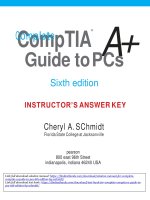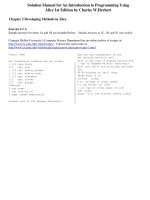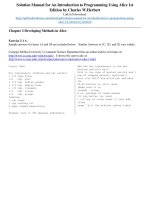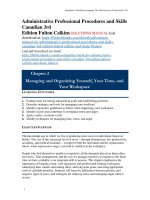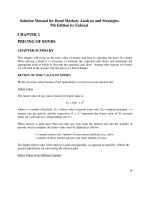Solution manual for internal auditing assurance and consulting services 2nd edition by reding
Bạn đang xem bản rút gọn của tài liệu. Xem và tải ngay bản đầy đủ của tài liệu tại đây (55.03 KB, 6 trang )
CHAPTER 1
INTRODUCTION TO INTERNAL AUDITING
Illustrative Solutions
Review Questions
1. The Institute of Internal Auditors’ (IIA’s) definition: “Internal auditing is an independent, objective
assurance and consulting activity designed to add value and improve an organization’s operations. It
helps an organization accomplish its objectives by bringing a systematic, disciplined approach to
evaluate and improve the effectiveness of risk management, control, and governance processes.”
2. An organization’s objectives define what the organization wants to achieve. The organization’s
strategy defines how management plans to achieve the objectives.
3. According to the Committee of Sponsoring Organizations of the Treadway Commission (COSO)
ERM Framework, the four categories of business objectives introduced in this chapter are:
• Strategic objectives, which pertain to the value creation choices management makes on behalf of
the organization’s stakeholders.
• Operations objectives, which pertain to the effectiveness and efficiency of the organization’s
operations, including performance and profitability goals and safeguarding resources against loss.
• Reporting objectives, which pertain to the reliability of internal and external reporting of financial
and nonfinancial information.
• Compliance objectives, which pertain to adherence to applicable laws and regulations.
4. Governance is the process conducted by the board of directors to authorize, direct, and oversee
management toward the achievement of the organization’s objectives. Risk management is the
process conducted by management to understand and deal with uncertainties (risks and opportunities)
that could affect the organization’s ability to achieve its objectives. Control, as defined in this
chapter, is the process conducted by management to mitigate risks to acceptable levels. Please see the
textbook glossary for separate definitions of controls, internal control, and system of internal controls.
5. Internal assurance services involve an objective examination of evidence for the purpose of providing
an independent assessment on the effectiveness of governance, risk management, and control
processes for the organization. Internal consulting services are advisory and related services, the
nature and scope of which are agreed to with the customer and that are intended to improve an
organization’s governance, risk management, and control processes without the internal auditor
assuming management responsibility.
6. Independence refers to the organizational status of the internal audit function and reflects the freedom
from conditions that threaten objectivity or the appearance of objectivity. Individual objectivity is an
impartial, unbiased mental attitude and involves avoiding conflicts of interest, which allows internal
auditors to perform engagements in such a manner that they have an honest belief in their work
product and that no significant quality compromises are made.
7. The three fundamental phases in the internal audit engagement process are planning the engagement,
performing the engagement, and communicating engagement outcomes.
8. “The relationship of auditing to accounting is close, yet their natures are very different; they are
business associates, not parent and child. Accounting includes the collection, classification,
summarization, and communication of financial data; it involves the measurement and
communication of business events and conditions as they affect and represent a given enterprise or
other entity. The task of accounting is to reduce a tremendous mass of detailed information to
manageable and understandable proportions. Auditing does none of these things. Auditing must
consider business events and conditions too, but it does not have the task of measuring or
Internal Auditing: Assurance and Consulting Services, 2nd Edition. © 2009 by The Institute of Internal Auditors
Research Foundation, 247 Maitland Avenue, Altamonte Springs, FL 32701 USA
IS1-1
CHAPTER 1
INTRODUCTION TO INTERNAL AUDITING
Illustrative Solutions
communicating them. Its task is to review the measurements and communications of accounting for
propriety. Auditing is analytical, not constructive; it is critical, investigative, concerned with the basis
for accounting measurements and assertions. Auditing emphasizes proof, the support for financial
statements and data. Thus auditing has its principal roots, not in accounting which it reviews, but in
logic on which it leans heavily for ideas and methods.” — Mautz and Sharaf, Philosophy of Auditing
9. The primary difference between internal financial reporting assurance services and external financial
reporting assurance services is the audience. Internal auditors provide financial reporting assurance
services primarily for the benefit of management and the board of directors. Independent outside
auditors provide financial reporting assurance services primarily for the benefit of third parties.
10. Factors that have fueled the dramatic increase in demand for internal audit services over the past 30
years include globalization, increasingly complex corporate structures, e-commerce and other
technological advances, and a global economic downturn.
11. The types of procedures an internal auditor might use to test the design adequacy and operating
effectiveness of governance, risk management, and control processes include:
• Inquiring of managers and employees.
• Observing activities.
• Inspecting resources and documents.
• Reperforming control activities.
• Performing trend and ratio analysis.
• Performing data analysis using computer-assisted audit techniques.
• Gathering corroborating information from independent third parties.
• Performing direct tests of events and transactions.
12. Cosourcing means that an organization is supplementing its in-house internal audit function to some
extent via the services of third-party vendors. Common situations in which an organization will
cosource its internal audit function include circumstances in which the third-party vendor has
specialized audit knowledge and skills that the organization does not have in-house and circumstances
in which the organization has insufficient in-house internal audit resources to fully complete its
planned engagements.
13. The IIA’s official motto is “Progress Through Sharing.”
14. The IIA headquarters leadership team includes the president and CEO and the chief staff officers over
global operations, North American operations, and shared services. Hundreds of volunteers also
provide IIA leadership. These leaders include the 38-member IIA Board of Directors, international
committees, district representatives, and officers and board members of the various national institutes.
15. The two categories of guidance included in the International Professional Practices Framework
(IPPF) are mandatory guidance, which includes the Definition of Internal Auditing, the Code of
Ethics, and the International Standards for the Professional Practice of Internal Auditing
(Standards), and strongly recommended guidance, which includes Practice Advisories, Position
Papers, and Practice Guides.
16. The Certified Internal Auditor (CIA) exam tests a candidate’s expertise in four parts:
• The Internal Audit Activity’s Role in Governance, Risk, and Control.
• Conducting the Internal Audit Engagement.
Internal Auditing: Assurance and Consulting Services, 2nd Edition. © 2009 by The Institute of Internal Auditors
Research Foundation, 247 Maitland Avenue, Altamonte Springs, FL 32701 USA
IS1-2
CHAPTER 1
INTRODUCTION TO INTERNAL AUDITING
Illustrative Solutions
•
•
Business Analysis and Information Technology.
Business Management Skills.
17. The Institute of Internal Auditors Research Foundation’s (IIARF’s) major objective is “to support
research and education in internal auditing, thereby enhancing the development of the internal audit
profession.”
18. Inherent personal qualities that are common among successful internal auditors include integrity,
passion, work ethic, curiosity, creativity, initiative, and flexibility.
19. Internal auditors must have integrity because the users of their work products rely on the internal
auditors’ professional judgments to make important business decisions. These stakeholders must have
confidence that internal auditors are trustworthy.
20. The four areas are interpersonal skills, tools and techniques, internal audit standards, theory, and
methodology, and knowledge areas.
21. Many individuals now enter the internal audit profession directly out of school. Others switch to
internal auditing after beginning their careers in another area of the organization or in public
accounting. Some organizations require prospective managers to spend time working in internal
auditing as part of their management trainee program.
22. Most people who work in internal auditing do not spend their entire careers there. They instead use
internal auditing as a stepping stone into financial or nonfinancial management positions, either in the
organizations they have been working for or in other organizations.
23. Options that an individual has if he or she chooses to be a career internal auditor include progressing
upward through the ranks of a single organization’s internal audit function into internal audit
management, advancing up the ladder by moving from one organization to another, or moving
upward through the various levels in a firm that provides internal assurance and consulting services to
other organizations.
Multiple-choice Questions
1. A is the best answer. This answer is most closely aligned with The IIA’s definition of internal
auditing. Per the definition, internal auditing comprises assurance and consulting activities and is
designed to add value and improve an organization’s operations. The other answers may represent
appropriate activities for an internal audit function, but they do not represent its overall responsibility.
2. D is the best answer. An organization’s strategy, not its objectives, is management’s means of
employing resources and assigning responsibilities. It defines how management plans to achieve the
organization’s objectives.
3. A is the best answer. Assurance services are defined in the glossary to the Standards as “an objective
examination of evidence for the purpose of providing an independent assessment on governance, risk
management, or control processes for the organization. Examples may include financial, performance,
compliance, system security, and due diligence engagements.”
4. C is the best answer. Project management skills are important, but according to The IIA’s Internal
Auditor Competency Framework, this attribute falls in the Tools and Techniques competency
category. The other three are all part of the Interpersonal Skills competency category.
Internal Auditing: Assurance and Consulting Services, 2nd Edition. © 2009 by The Institute of Internal Auditors
Research Foundation, 247 Maitland Avenue, Altamonte Springs, FL 32701 USA
IS1-3
CHAPTER 1
INTRODUCTION TO INTERNAL AUDITING
Illustrative Solutions
5. B is the best answer. Internal auditors need to develop an understanding of the auditee’s objectives
and risks during the planning stages of an engagement. The internal auditor will use the auditee’s
business objectives, together with the risks that threaten those objectives, as a framework for defining
the desired outcomes of the engagement. The other answers may be part of an assurance engagement,
but understanding the auditee would not be sufficient for the internal auditors to meet these
objectives.
Discussion Questions
1. Objectives define what an individual or organization wants to achieve. Strategies define how
individuals or organizations plan to achieve their objectives.
A common objective expressed by students is to achieve a good grade. Some students indicate that
they want to learn. These responses open the door for the instructor to discuss the relationship
between objectives and key performance indicators. If the instructor’s grading criteria are aligned
with his or her student learning objectives, the grades students earn in the course should reflect their
levels of learning.
An appropriate strategy for learning and achieving a good grade in a course includes:
• Obtaining a clear understanding of the instructor’s expectations and grading criteria.
• Attending all class sessions.
• Actively participating in class discussions.
• Completing all assignments on a timely basis.
• Studying diligently throughout the semester instead of just before exams.
• Communicating with the instructor in a timely manner if problems are encountered.
2. The student’s objective is to get to her 8:00 a.m. class on time. Students may encounter several
different risks that threaten this objective and the corresponding controls that can be implemented to
mitigate these risks. Simple examples of risks and controls include:
Risks
Oversleeping
Missing the bus
•
•
•
•
•
Controls
Getting to bed at a reasonable time
Setting an alarm clock
Packing books and supplies before going to bed
Planning in advance the activities that must be
completed in the morning before leaving the house
Allowing sufficient time to walk to the bus stop
3. The point to this question is that monitoring activities such as trend analysis are most effective when
observed performance is compared with predetermined expectations. It would be reasonable for the
owner of the flower shops to expect sales to be higher in certain months, for example in February
because of Valentine’s Day and in March or April, depending on when Easter occurs. Accordingly,
the fact that monthly sales remained relatively consistent at the one shop over the six-month period
should be reason for concern, especially if the sales performance at this shop was inconsistent with
Internal Auditing: Assurance and Consulting Services, 2nd Edition. © 2009 by The Institute of Internal Auditors
Research Foundation, 247 Maitland Avenue, Altamonte Springs, FL 32701 USA
IS1-4
CHAPTER 1
INTRODUCTION TO INTERNAL AUDITING
Illustrative Solutions
the sales performance at the other four shops. This question also illustrates the value of internal
benchmarking, that is, the comparison of performance among comparable business units.
4. a. Inherent personal qualities common among successful internal auditors include, for example:
• Integrity.
• Passion.
• Work ethic.
• Curiosity.
• Creativity.
• Initiative.
• Flexibility.
• Competitiveness.
• Commitment to excellence.
• Inquisitiveness.
• Confidence.
• Professionalism.
b. The knowledge and skills entry-level internal auditors are expected to possess include, for
example:
• Knowledge of internal auditing and audit-related subjects such as accounting, management,
and information technology.
• Understanding the concepts of business objectives, risks, and controls.
• Hands-on working knowledge of audit-related software such as flowcharting software and
generalized audit software.
• Oral and written communication skills.
• Analytical, problem-solving skills.
Credentials that entry-level internal auditors are expected to possess include, for example:
• A good GPA.
• Scholarships.
• An internship or other relevant work experience.
• Active involvement in a student organization such as an IIA student chapter or a business
fraternity.
• Although not yet common, completion of one or more parts of the CIA exam by students
before they graduate is rising.
c. Additional knowledge and skills in-charge internal auditors might be expected to possess include,
for example:
• An in-depth knowledge of the organization and its industry.
• Specialized subject matter expertise in more than one area such as accounting, technology,
emerging regulations, enterprise risk management, or control self-assessment.
• Communicating effectively and building rapport with management.
• Coaching subordinates and sharing expertise.
• Making presentations to and facilitating meetings of management personnel.
Credentials in-charge internal auditors are expected to possess include, for example:
• Professional certification such as a CIA, Certified Public Accountant (CPA), Chartered
Accountant (CA), or Certified Information Systems Auditor (CISA).
Internal Auditing: Assurance and Consulting Services, 2nd Edition. © 2009 by The Institute of Internal Auditors
Research Foundation, 247 Maitland Avenue, Altamonte Springs, FL 32701 USA
IS1-5
CHAPTER 1
INTRODUCTION TO INTERNAL AUDITING
Illustrative Solutions
•
A developing track record of successfully leading engagements that is reflected in positive
performance evaluations and complimentary feedback from service recipients.
Additional knowledge and skills chief audit executives (CAEs) might be expected to possess include,
for example:
• Deep expertise in governance, risk management, and control.
• Commanding respect among senior executives.
• Thinking strategically and stimulating change within the organization.
• Building and sustaining an internal audit function that adds value to the organization.
Credentials internal audit executives are expected to possess include, for example:
• A history of successful professional advancement and leadership.
• A reputation inside and outside the organization as a thought leader in governance, risk
management, and control.
Case
The purpose of this case is twofold: (1) to expose students to The IIA’s website and (2) to have the
students study pertinent information about the internal audit profession. Individual instructors should
customize the assignment to align it with their specific goals. As of the date this textbook was published,
the web addresses for the two questions can be found at the following links. Instructors should check
these links in advance to ensure they still contain the information requested in the case, and modify the
case as necessary should the information on the website change.
1. />2. />
Internal Auditing: Assurance and Consulting Services, 2nd Edition. © 2009 by The Institute of Internal Auditors
Research Foundation, 247 Maitland Avenue, Altamonte Springs, FL 32701 USA
IS1-6

